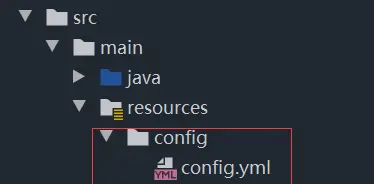前言
前阵子和朋友聊天,他手头上有个spring单体项目,每次数据库配置变更,他都要重启项目,让配置生效。他就想说有没有什么办法,不重启项目,又可以让配置生效。当时我就跟他说,可以用配置中心,他的意思是因为是维护类项目,不想再额外引入一个配置中心,增加运维成本。后边跟他讨论了一个方案,可以实现一个监听配置文件变化的程序,当监听到文件变化,进行相应的变更操作。具体流程如下
在这些步骤,比较麻烦就是如何动态刷新bean,因为朋友是spring项目,今天就来聊下在spring项目中如何实现bean的动态刷新
实现思路
了解spring的朋友,应该知道spring的单例bean是缓存在singletonObjects这个map里面,所以可以通过变更singletonObjects来实现bean的刷新。我们可以通过调用removeSingleton和addSingleton这两个方法来实现,但是这种实现方式的缺点就是会改变bean的生命周期,会导致原来的一些增强功能失效,比如AOP。但spring作为一个极其优秀的框架,他提供了让我们自己管理bean的扩展点。这个扩展点就是通过指定scope,来达到自己管理bean的效果
实现步骤
1、自定义scope
public class RefreshBeanScope implements Scope {
private final Map<String,Object> beanMap = new ConcurrentHashMap<>(256);
@Override
public Object get(String name, ObjectFactory<?> objectFactory) {
if(beanMap.containsKey(name)){
return beanMap.get(name);
}
Object bean = objectFactory.getObject();
beanMap.put(name,bean);
return bean;
}
@Override
public Object remove(String name) {
return beanMap.remove(name);
}
@Override
public void registerDestructionCallback(String name, Runnable callback) {
}
@Override
public Object resolveContextualObject(String key) {
return null;
}
@Override
public String getConversationId() {
return null;
}
}
2、自定义scope注册
public class RefreshBeanScopeDefinitionRegistryPostProcessor implements BeanDefinitionRegistryPostProcessor {
@Override
public void postProcessBeanDefinitionRegistry(BeanDefinitionRegistry registry) throws BeansException {
}
@Override
public void postProcessBeanFactory(ConfigurableListableBeanFactory beanFactory) throws BeansException {
beanFactory.registerScope(SCOPE_NAME,new RefreshBeanScope());
}
}
3、自定义scope注解(可选)
@Target({ ElementType.TYPE, ElementType.METHOD })
@Retention(RetentionPolicy.RUNTIME)
@Scope("refreshBean")
@Documented
public @interface RefreshBeanScope {
/**
* @see Scope#proxyMode()
* @return proxy mode
*/
ScopedProxyMode proxyMode() default ScopedProxyMode.TARGET_CLASS;
}
4、编写自定义scope bean刷新逻辑
@RequiredArgsConstructor
public class RefreshBeanScopeHolder implements ApplicationContextAware {
private final DefaultListableBeanFactory beanFactory;
private ApplicationContext applicationContext;
public List<String> refreshBean(){
String[] beanDefinitionNames = beanFactory.getBeanDefinitionNames();
List<String> refreshBeanDefinitionNames = new ArrayList<>();
for (String beanDefinitionName : beanDefinitionNames) {
BeanDefinition beanDefinition = beanFactory.getBeanDefinition(beanDefinitionName);
if(SCOPE_NAME.equals(beanDefinition.getScope())){
beanFactory.destroyScopedBean(beanDefinitionName);
beanFactory.getBean(beanDefinitionName);
refreshBeanDefinitionNames.add(beanDefinitionName);
applicationContext.publishEvent(new RefreshBeanEvent(beanDefinitionName));
}
}
return Collections.unmodifiableList(refreshBeanDefinitionNames);
}
@Override
public void setApplicationContext(ApplicationContext applicationContext) throws BeansException {
this.applicationContext = applicationContext;
}
}
以上步骤就是实现自定义scope管理bean的过程,下面我们以一个配置变更实现bean刷新例子,来演示以上步骤
示例
1、在项目src/main/rescoures目录下创建属性配置文件config/config.properties
并填入测试内容
test:
name: zhangsan2222
2、将config.yml装载进spring
public static void setConfig() {
String configLocation = getProjectPath() + "/src/main/resources/config/config.yml";
System.setProperty("spring.config.additional-location",configLocation);
}
public static String getProjectPath() {
String basePath = ConfigFileUtil.class.getResource("").getPath();
return basePath.substring(0, basePath.indexOf("/target"));
}
3、实现配置监听
注: 利用hutool的WatchMonitor或者apache common io的文件监听即可实现
以apache common io为例
a、 业务pom文件引入common-io gav
<dependency>
<groupId>commons-io</groupId>
<artifactId>commons-io</artifactId>
<version>${common-io.version}</version>
</dependency>
b、 自定义文件变化监听器
@Slf4j
public class ConfigPropertyFileAlterationListener extends FileAlterationListenerAdaptor {
private ApplicationContext applicationContext;
public ConfigPropertyFileAlterationListener(ApplicationContext applicationContext) {
this.applicationContext = applicationContext;
}
@Override
public void onStart(FileAlterationObserver observer) {
super.onStart(observer);
}
@Override
public void onDirectoryCreate(File directory) {
super.onDirectoryCreate(directory);
}
@Override
public void onDirectoryChange(File directory) {
super.onDirectoryChange(directory);
}
@Override
public void onDirectoryDelete(File directory) {
super.onDirectoryDelete(directory);
}
@Override
public void onFileCreate(File file) {
super.onFileCreate(file);
}
@Override
public void onFileChange(File file) {
log.info(">>>>>>>>>>>>>>>>>>>>>>>>> Monitor PropertyFile with path --> {}",file.getName());
refreshConfig(file);
}
@Override
public void onFileDelete(File file) {
super.onFileDelete(file);
}
@Override
public void onStop(FileAlterationObserver observer) {
super.onStop(observer);
}
}
c、 启动文件监听器
@SneakyThrows
private static void monitorPropertyChange(FileMonitor fileMonitor, File file,ApplicationContext context){
if(fileMonitor.isFileScanEnabled()) {
String ext = "." + FilenameUtils.getExtension(file.getName());
String monitorDir = file.getParent();
//轮询间隔时间
long interval = TimeUnit.SECONDS.toMillis(fileMonitor.getFileScanInterval());
//创建文件观察器
FileAlterationObserver observer = new FileAlterationObserver(
monitorDir, FileFilterUtils.and(
FileFilterUtils.fileFileFilter(),
FileFilterUtils.suffixFileFilter(ext)));
observer.addListener(new ConfigPropertyFileAlterationListener(context));
//创建文件变化监听器
FileAlterationMonitor monitor = new FileAlterationMonitor(interval, observer);
//开始监听
monitor.start();
}
}
4、监听文件变化,并实现PropertySource以及bean的刷新
@SneakyThrows
private void refreshConfig(File file){
ConfigurableEnvironment environment = applicationContext.getBean(ConfigurableEnvironment.class);
MutablePropertySources propertySources = environment.getPropertySources();
PropertySourceLoader propertySourceLoader = new YamlPropertySourceLoader();
List<PropertySource<?>> propertySourceList = propertySourceLoader.load(file.getAbsolutePath(), applicationContext.getResource("file:"+file.getAbsolutePath()));
for (PropertySource<?> propertySource : propertySources) {
if(propertySource.getName().contains(file.getName())){
propertySources.replace(propertySource.getName(),propertySourceList.get(0));
}
}
RefreshBeanScopeHolder refreshBeanScopeHolder = applicationContext.getBean(RefreshBeanScopeHolder.class);
List<String> strings = refreshBeanScopeHolder.refreshBean();
log.info(">>>>>>>>>>>>>>> refresh Bean :{}",strings);
}
5、测试
a、 编写controller并将controller scope设置为我们自定义的scope
@RestController
@RequestMapping("test")
@RefreshBeanScope
public class TestController {
@Value("${test.name: }")
private String name;
@GetMapping("print")
public String print(){
return name;
}
}
原来的test.name内容如下
test:
name: zhangsan2222
我们通过浏览器访问
b、 此时我们不重启服务器,并将test.name改为如下
test:
name: zhangsan3333
此时发现控制台会输出我们的日志信息
通过浏览器再访问
发现内容已经发生变化
附录:自定义scope方法触发时机
1、scope get方法
// Create bean instance.
if (mbd.isSingleton()) {
sharedInstance = getSingleton(beanName, () -> {
try {
return createBean(beanName, mbd, args);
}
catch (BeansException ex) {
// Explicitly remove instance from singleton cache: It might have been put there
// eagerly by the creation process, to allow for circular reference resolution.
// Also remove any beans that received a temporary reference to the bean.
destroySingleton(beanName);
throw ex;
}
});
bean = getObjectForBeanInstance(sharedInstance, name, beanName, mbd);
}
else if (mbd.isPrototype()) {
// It's a prototype -> create a new instance.
Object prototypeInstance = null;
try {
beforePrototypeCreation(beanName);
prototypeInstance = createBean(beanName, mbd, args);
}
finally {
afterPrototypeCreation(beanName);
}
bean = getObjectForBeanInstance(prototypeInstance, name, beanName, mbd);
}
else {
String scopeName = mbd.getScope();
final Scope scope = this.scopes.get(scopeName);
if (scope == null) {
throw new IllegalStateException("No Scope registered for scope name '" + scopeName + "'");
}
try {
Object scopedInstance = scope.get(beanName, () -> {
beforePrototypeCreation(beanName);
try {
return createBean(beanName, mbd, args);
}
finally {
afterPrototypeCreation(beanName);
}
});
bean = getObjectForBeanInstance(scopedInstance, name, beanName, mbd);
}
catch (IllegalStateException ex) {
throw new BeanCreationException(beanName,
"Scope '" + scopeName + "' is not active for the current thread; consider " +
"defining a scoped proxy for this bean if you intend to refer to it from a singleton",
ex);
}
}
}
catch (BeansException ex) {
cleanupAfterBeanCreationFailure(beanName);
throw ex;
}
触发时机就是在调用getBean时触发
2、scope remove方法
@Override
public void destroyScopedBean(String beanName) {
RootBeanDefinition mbd = getMergedLocalBeanDefinition(beanName);
if (mbd.isSingleton() || mbd.isPrototype()) {
throw new IllegalArgumentException(
"Bean name '" + beanName + "' does not correspond to an object in a mutable scope");
}
String scopeName = mbd.getScope();
Scope scope = this.scopes.get(scopeName);
if (scope == null) {
throw new IllegalStateException("No Scope SPI registered for scope name '" + scopeName + "'");
}
Object bean = scope.remove(beanName);
if (bean != null) {
destroyBean(beanName, bean, mbd);
}
}
触发时机实在调用destroyScopedBean方法
总结
如果对spring cloud RefreshScope有研究的话,就会发现上述的实现方式,就是RefreshScope的粗糙版本实现
demo链接
共同学习,写下你的评论
评论加载中...
作者其他优质文章









